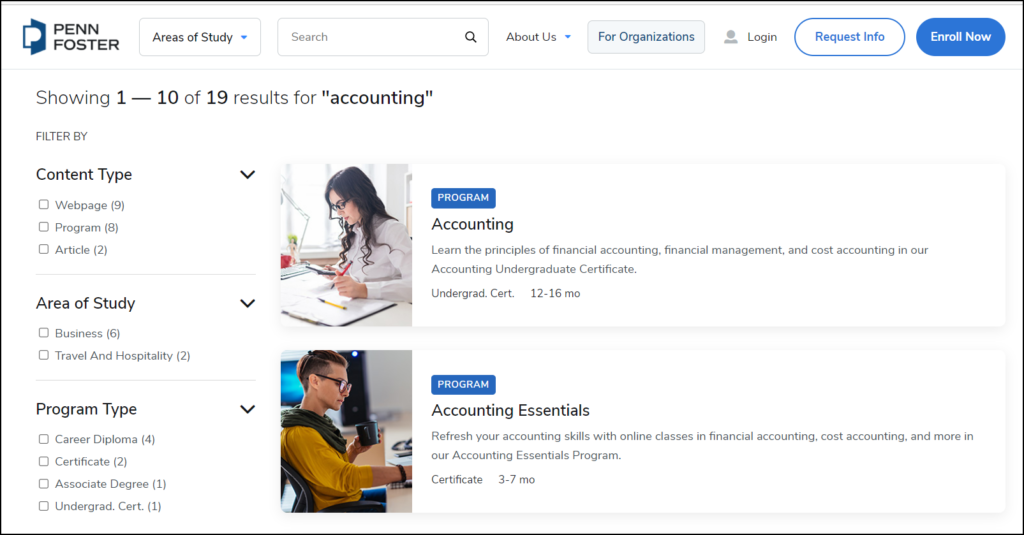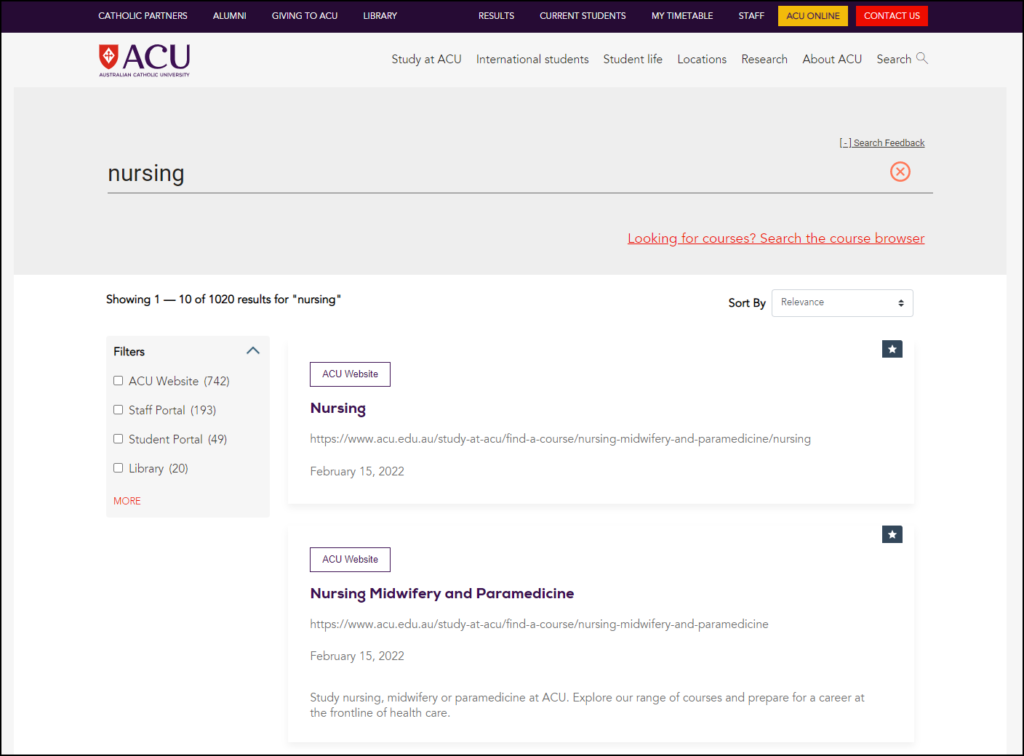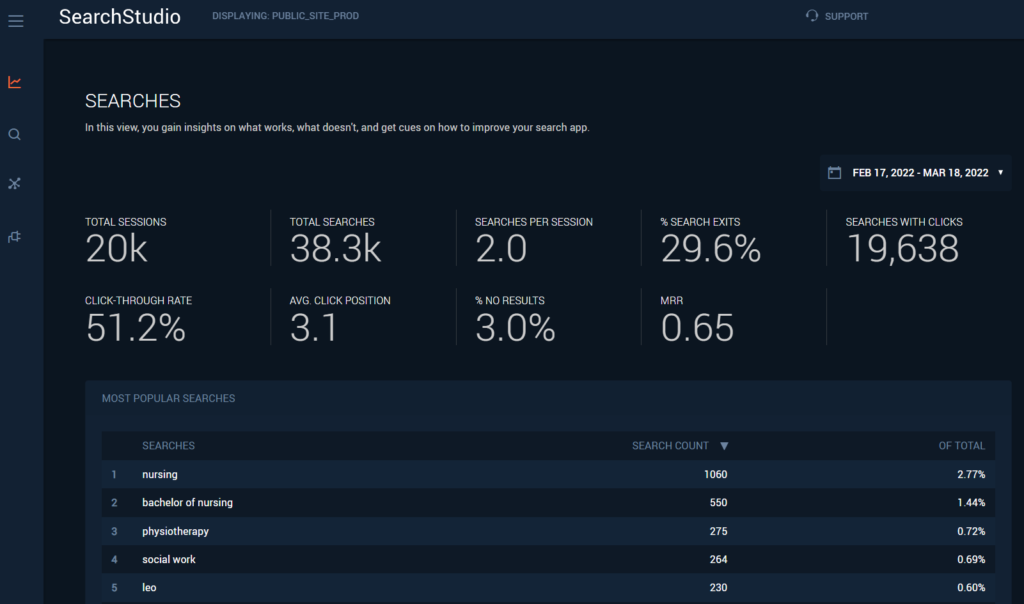
Mar. 22, 2024
Tom Humbarger
|
There are over 1 million fewer students enrolled in college compared to before the pandemic began, and this is a trend that has been declining since 2015. With enrollment on the decline, many colleges and universities are struggling to attract new students.
One of the major ways colleges market themselves to prospective students is through their website. While most of these websites contain flashy images of happy students on photogenic campuses, many colleges have ignored the basic needs of the prospective students using their websites – specifically in the area of website search best practices for higher education.
Websites for higher education are packed with information, but that can make it difficult for potential students to find a specific webpage.
Today’s Gen Z students – those born between the late 1990s to the early 2010s – practically grew up online, and their expectations for digital experiences have set a new bar that colleges and universities need to meet. Understanding the needs of Gen Z “customers” is critical to attracting students to university websites and getting prospective students to apply and enroll.
One often overlooked feature for higher education websites is optimizing the search functionality. Many users end up using the search function because they don’t want to take the time to learn how a website is organized; it’s easier for them to type into the search bar. In most cases, they are left even more confused when wading through pages of poorly organized search results.
Understanding what Gen Z customers need and expect is critical to winning them over. For example, 70% of Gen Z users expect websites to know what they are searching for before they even enter any information. They also expect the search function to behave like the familiar Google Search with relevant information at the top of the search results. Those are high expectations, but you can live up to them by following website search best practices for your higher education website.
When users visit your website, they’re usually looking for specific information. Maybe they want to learn about the courses you offer, see what sports or extracurricular programs are available or get information on professors and the admission process.
For example, Penn Foster is a pioneer in online education and offers degrees in 22 bachelor and associate degree programs. When a user visits the Penn Foster website, they are greeted with a prominent search bar. Using the search function, a user can filter by Content Type (Webpage, Program or Article), Area of Study or Program Type. The results are also optimized to provide a title and short description of the content on the page.
Imagine for a moment that you enter a library searching for a specific book. However, you soon realize that the vast library has no categorization system and no one is around to help you. The books aren’t even in alphabetical order, and the groupings don’t make sense.
In this situation, you’d likely leave the library and look for another that has a more comprehensive system to help your search. It’s the same for your higher education website.

A website search that is well-organized and presents information like Penn Foster’s can make a huge difference. If someone doesn’t have the time or patience to sift through your entire website, this can give them what they need faster. Search features will leave a good impression on website visitors who find the information they are seeking quickly and easily.
Often, prospective students start with a very basic web search such as the “best colleges for business” or the “best university for computer science.” They might have an interest and a rough goal in mind, but not a school yet. Once they come to your website, they are likely looking for information on majors, admission requirements, research or campus life.
For current or serious prospective students, searching for courses is a primary need and the site search should be intuitive. A comprehensive and effective search function will include query suggestions that appear as users type. Remember that results should be based on relevance and need to take searchers’ typos into account.
At Australian Catholic University in Australia, there is a primary search bar plus a “Search for a Course” feature on the home page. This only returns information about specific courses without providing extraneous information.

Another best practice is to make it easy to access your list of courses and majors. What does your university or college offer that other schools do not? How is your institution different, and how can that benefit students? Can users filter by programs or schools, such as arts, architecture, engineering, and so on?
These are all questions you have to ask yourself as you consider your current website. If your higher education website falls short, it’s time to take a look at the analytics to find out why.
It’s easy to say you need to think like your intended audience, but how can you start? First, you need to determine the needs of your users and understand what they are searching for and what content resonates with them.
Google Analytics can identify what webpages are being viewed, but it won’t show you what is being searched from the website search function or what content is being accessed by those searches. To fully get a handle on search analytics, you’ll need an analytics tool like site search analytics from SearchStax. Site Search has a dashboard that provides an overview of the search activity on a website including total sessions, total number of searches, searches with clicks, click-through rates, average search position and more.

The analytics also identify the most popular searches, which can help in understanding content gaps, and top-viewed content, which shows the most important content on a website. Search KPIs can give you a better idea of how well you’re reaching new students and the effectiveness of your marketing efforts.
Seeing total search volume and breaking it down by the clicks you get and your click-through rate can give you a better idea of how your website is performing and where you can make changes.
Your higher education website needs to follow and implement these website search best practices for search analytics, accessibility and personalization if you hope to win over new students. The best place to start is to conduct a deep analysis of where your website falls short, research other websites to see how search can be improved and consider the needs of your user.
With rich search analytics, you will be able to get a clear picture of what users are looking for when they do a search, which can help you make improvements to your website. Insights will help make your higher education websites easier to use and more relevant to your target audience.
You will also need to personalize search results and cater to your audience to provide an optimal experience. Using features like spell check, search synonyms, promoted content, boosting and AI-powered features like auto-suggest, related searches and related content will also help improve the user experience.
See how SearchStax Site Search elevates the search experience with better site search for higher education. Schedule a Site Search demo with our search experts to get an evaluation of search on your current website, see how search can be improved and discover how analytics and easy-to-use tools can drive the best practices to optimize search for your higher education website.
The Stack is delivered bi-monthly with industry trends, insights, products and more
Copyrights © SearchStax Inc.2014-2024. All Rights Reserved.
SearchStax Site Search solution is engineered to give marketers the agility they need to optimize site search outcomes. Get full visibility into search analytics and make real-time changes with one click.
close
SearchStax Managed Search service automates, manages and scales hosted Solr infrastructure in public or private clouds. Free up developers for value-added tasks and reduce costs with fewer incidents.
close
close